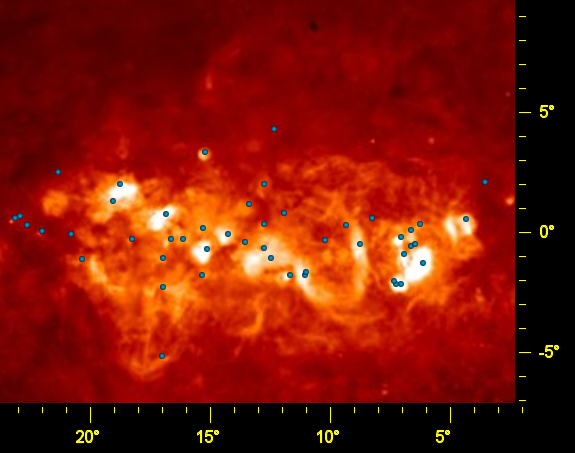
Hover your mouse over each blue dot for the name of the object, or click on the dot for a detail page. This map was created using the all-sky hydrogen-alpha map produced by Douglas Finkbeiner from data collected by the WHAM, VTSS and SHASSA hydrogen-alpha surveys.
The Eagle and Omega region is the largest and most active of a number of adjacent massive molecular cloud and star formation areas (which also include Ara OB1A, Scorpius OB1 - west and Scorpius OB1 - east) that are located immediately across a large gap inwards from the Orion Arc, and are usually described as being part of the Sagittarius arm of the Milky Way.
Most of the bright nebulae in the Eagle/Omega region are located at a distance of about 2-3000 parsecs and may be part of the Scutum Supershell, a huge structure containing 620 thousand solar masses of dust and gas that may be energised in part by the Serpens OB1 association. The most dynamic parts of this region include the Omega nebula (Sh 2-45, also called M17, W38, the Swan nebula, Horseshoe nebula and the Lobster nebula among many other names) and the Eagle nebula (Sh 2-49, M16 or W37).
The Omega nebula is a blister on the side of a 30 thousand solar mass giant molecular cloud. It is ionised by an O4V-O4V double star system (Kleinmann's star) which lies at the core of the massive young cluster NGC 6618. NGC 6618 is about one million years old and contains over 800 stars, including 2 O5V star systems and 100 stars hotter than B9. (By comparison, Orion has 8 stars hotter than B9.) The total ultraviolet flux is about 25 times higher than for Orion.
The Eagle nebula is ionized by the NGC 6611 star cluster, which is part of the Serpens OB1 association. A detail of the Eagle nebula, often called "The Pillars of Creation", became one of the Hubble Space Telescope's most famous images.
Also in a similar direction and distance to the Omega and Eagle nebulae are Sh 2-54 (W35), which is part of the OB association Serpens OB2, Sh 2-46, which is part of the OB association Sagittarius OB6, Sh 2-55 and many others. A schematic for the overall structure of the Scutum Supershell region can be found in Figure 9b of this 1996 paper.
The large nebular region below the galactic plane around 18° longitude appears to be blowout ejected from the Scutum Supershell. Sh 2-51 (LBN 65) appears to be located in the lower edge of this blowout.

The prominent circular nebula centered around (21.3°, 1.2°) appears to be ionised by the O5e star HD 169582. SIMBAD lists no HII region near this location and it appears that this nebula has never been catalogued. The image of this nebula to the left was created from a mosaic of nine SuperCOSMOS hydrogen-alpha images. It is perhaps not surprising that this nebula is unknown because the nebulosity is faint even in red-filtered plates - the nebula is only obvious in hydrogen-alpha. The full image at SuperCOSMOS resolution is also available here (warning this is a 6282x5859 18 megabyte file).
There are also many bright nebulae in foreground and background to the Omega complex but not too far away in the sky. These include the Lagoon nebula (Sh 2-25, M8) which at a distance of 1250 parsecs is well in front of the Omega complex (and likely connected to the Sagittarius OB1 association) and the Trifid nebula (Sh 2-30, M20) which at 3010 parsecs is slightly behind (News Flash! - it turns out that the Trifid nebula is actually only 816 parsecs away as I describe in this APOD discussion thread. I'll be moving the Trifid nebula (and many others) on the galaxy map as part of a larger re-organisation of the map based on important new star cluster studies later this year.)
RCW 151 and the smaller nebulae Sh 2-35 and Sh 2-37 are embedded in a dark and dusty 130 thousand mass molecular cloud at 1800 parsecs. Sh 2-35 is visible along the western edge of this cloud, and Sh 2-37 is visible through a hole in the cloud. This active star formation complex appears to be connected to the Sagittarius OB7 association. A recent database created by Kharchenko and collegues concludes that Sagittarius OB7 has approximately 70 members and lies at a distance of 1860 parsecs. Thus it needs to be moved slightly on the current map.
At the far left (east) of this image, lie Sh 2-57 and Sh 2-58. This pair of nebulae are visible together in the sky, divided by the dark nebula LDN 446 as this hydrogen-alpha image produced from SuperCosmos shows. However, their distance estimates are 1500 and 2470 parsecs respectively so their apparent closeness in the sky may only be accidental.
